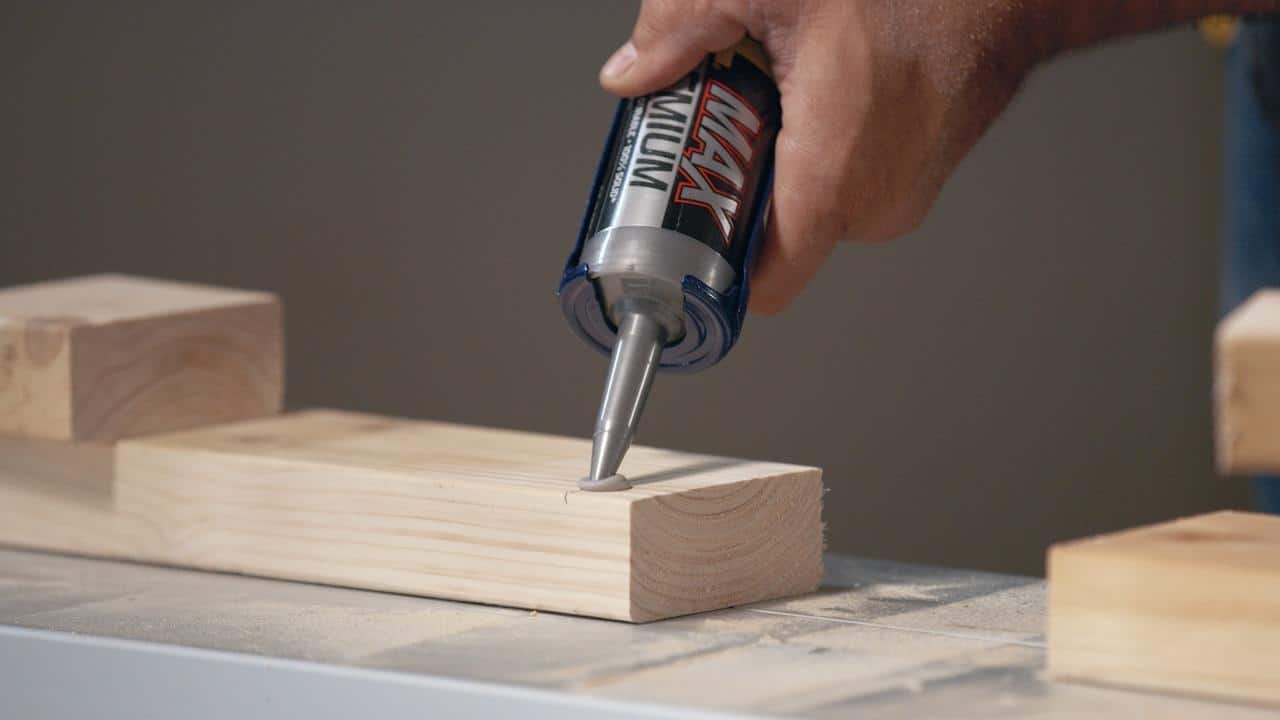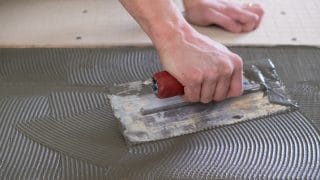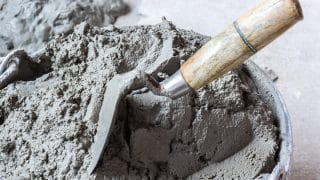
Go into the wood glue aisle of a big box store, and what you will find are mostly PVAs—polyvinyl acetate glues. The chemical compound that gives these water soluble, non-toxic glues their name was discovered more than a century ago, and since then they have been used to seal, prime, and join wood products together. PVA wood glue is ideal for bonding wood to wood, but it can also be used with other wood products: plywood, chipboard, and MDF.
The PVAs available today are often described as being stronger than the wood they join. The impressive bonding strength of wood glue can be verified through tests subjecting samples to typical stresses: shear, axial, and bending. In most cases, even including the world’s hardest woods, they will fail not along the glue joints but at other points where the wood itself will snap.
PVA Wood Glue
It’s likely that the first glue you ever used was a PVA: Elmer’s Glue. Wood glues are a particularly strong PVA.
The ingredient that makes PVAs effective as adhesives is polyvinyl acetate, a rubbery polymer that forms a hard bond as it dries. Among its strengths when it comes to wood (and some other porous materials) is that the glue seeps into the fibers, creating a stronger bond as it hardens.
“Where Super Glue uses moisture to cure,” builder and instructor Jordan Smith explains, “PVAs actually release their water. It dries as it cures.”
Available in different colors (carpenter’s glue is the common name for one with a yellowish hue, designed for outdoor use), wood glue is also sold in formulas that are intended for indoor applications as well as water resistant and waterproof ones.
You will typically want to clamp a PVA bond for the first 30 minutes to one hour while it sets as the glue dries. It takes 18 to 24 hours to cure completely.
How strong is wood glue?
Wood glue strength ranges from roughly 3,600 to 4,000 psi—that is they can withstand pressures of between 3,600 and 4,000 pounds per square inch.
The adhesive bonds of wood glues—as well as epoxies and polyurethane adhesives, both of which can also be used to join wood—are stronger than most woods. That means the wood will most likely fail before the bond does.
When to use PVA wood glue
PVA wood glue is used extensively in furniture, cabinet making, and finish carpentry, and often used in conjunction with a fastener. Fasteners are often used to hold the joint tight as the adhesive cures. The final product will be held together with the strength of the glue, but the nail holds it in place until the glue builds to its final strength.
Go into the wood glue aisle of a big box store, and what you will find are mostly PVAs—polyvinyl acetate glues. The chemical compound that gives these water soluble, non-toxic glues their name was discovered more than a century ago, and since then they have been used to seal, prime, and join wood products together. PVA wood glue is ideal for bonding wood to wood, but it can also be used with other wood products: plywood, chipboard, and MDF.
The PVAs available today are often described as being stronger than the wood they join. The impressive bonding strength of wood glue can be verified through tests subjecting samples to typical stresses: shear, axial, and bending. In most cases, even including the world’s hardest woods, they will fail not along the glue joints but at other points where the wood itself will snap.
PVA Wood Glue
It’s likely that the first glue you ever used was a PVA: Elmer’s Glue. Wood glues are a particularly strong PVA.
The ingredient that makes PVAs effective as adhesives is polyvinyl acetate, a rubbery polymer that forms a hard bond as it dries. Among its strengths when it comes to wood (and some other porous materials) is that the glue seeps into the fibers, creating a stronger bond as it hardens.
“Where Super Glue uses moisture to cure,” builder and instructor Jordan Smith explains, “PVAs actually release their water. It dries as it cures.”
Available in different colors (carpenter’s glue is the common name for one with a yellowish hue, designed for outdoor use), wood glue is also sold in formulas that are intended for indoor applications as well as water resistant and waterproof ones.
You will typically want to clamp a PVA bond for the first 30 minutes to one hour while it sets as the glue dries. It takes 18 to 24 hours to cure completely.
How strong is wood glue?
Wood glue strength ranges from roughly 3,600 to 4,000 psi—that is they can withstand pressures of between 3,600 and 4,000 pounds per square inch.
The adhesive bonds of wood glues—as well as epoxies and polyurethane adhesives, both of which can also be used to join wood—are stronger than most woods. That means the wood will most likely fail before the bond does.
When to use PVA wood glue
PVA wood glue is used extensively in furniture, cabinet making, and finish carpentry, and often used in conjunction with a fastener. Fasteners are often used to hold the joint tight as the adhesive cures. The final product will be held together with the strength of the glue, but the nail holds it in place until the glue builds to its final strength.
Other types of glues for joining wood
While the phrase “wood glue” typically refers to PVAs—and PVA wood glue is intended to be used exclusively on wood—for some specific situations you may want to use another type of adhesive—such as an epoxy—to join wood.
Polyurethane Glue
Polyurethane glue (often called by its brand name, Gorilla Glue) works on a number of different materials: wood, stone, metal, ceramic, glass, and more. While wood glue hardens as it dries, polyurethane requires moisture to cure. It is roughly as strong as PVA, with both shear and tensile strengths in the range of roughly 3,000 to 3,500 psi.
Because of its limited shelf life (of about a year), its expensive price, and its shorter working time, wood glue is a more popular option than polyurethane for many wood tasks. Polyurethane glue does, however, have applications where it excels, like joining two irregular pieces of wood (where it will expand to fill gaps in the wood joint).
Two-part Epoxies
Epoxies are used to join a variety of materials and make repairs to everything from plumbing to stone and ceramic details—their use is not limited to wood. The bond is similar in strength to that of a PVA glue, in the range of 2,000 to 4,000 psi.
Epoxies are more complicated to apply (given the two-part process of most of them) and they are more expensive, but they work well in cases where uneven pieces are being joined as the epoxy acts as a filler. Another advantage is that many epoxies are completely waterproof, something that is not true of some PVA glues. Finally, epoxies come in a range of working and curing times, with working (or pot) times as short as 15 minutes. In general, the longer the curing time, the stronger the bond.
Natural Protein Solutions
When bonded wood products like plywood and glulam (glue laminated wood) were first developed, glue from natural proteins was used to join the wood layers. Over time those were displaced by petroleum-based products, but in recent years there has been a revised interest in natural protein glues (and, especially in the United States, ones made from soy products). They offer an environmentally friendly and less toxic alternative to petroleum-based glues. The strength of the glue is modest (at under 300 psi) compared to epoxies, wood glues, and polyurethane ones but sufficient for their intended use: joining layers of bonded wood products.
5 Tips for working with wood glue
A few different factors help determine how long it will take for an adhesive to harden and how secure the bond will be.
- Keep it dry. PVAs harden as they dry, and when both the humidity in the air and the moisture in the wood are low, these glues will cure faster.
- Heat it up. Warmer temperatures, in general, speed up the curing process. Depending on the size of the bond, blowing hot air over it using a hair dryer can speed up the hardening of the glue.
- Ventilate. Bonds in well ventilated spaces tend to cure faster and for some glues, like epoxies, good ventilation is essential as the fumes are toxic.
- Clean surfaces. At a minimum, you will want to wipe away any dust or other debris before gluing the wood pieces together. If there are any oils or grease on the surface, you’ll may want to wash it with soap and water or sand it. Some tropical hardwoods produce their own oils that can interfere with PVAs and other glues. A thinner may be needed to remove these oils before attempting to glue the wood.
- Be frugal. Unless you intend for the adhesive to function as a filler, limit the amount of glue to what is necessary. Excess glue simply lengthens the curing time and may also result in a weaker, and messier, bond.
MT Copeland offers video-based online classes that give you a foundation in construction fundamentals with real-world applications. Classes include professionally produced videos taught by practicing craftspeople, and supplementary downloads like quizzes, blueprints, and other materials to help you master the skills.







